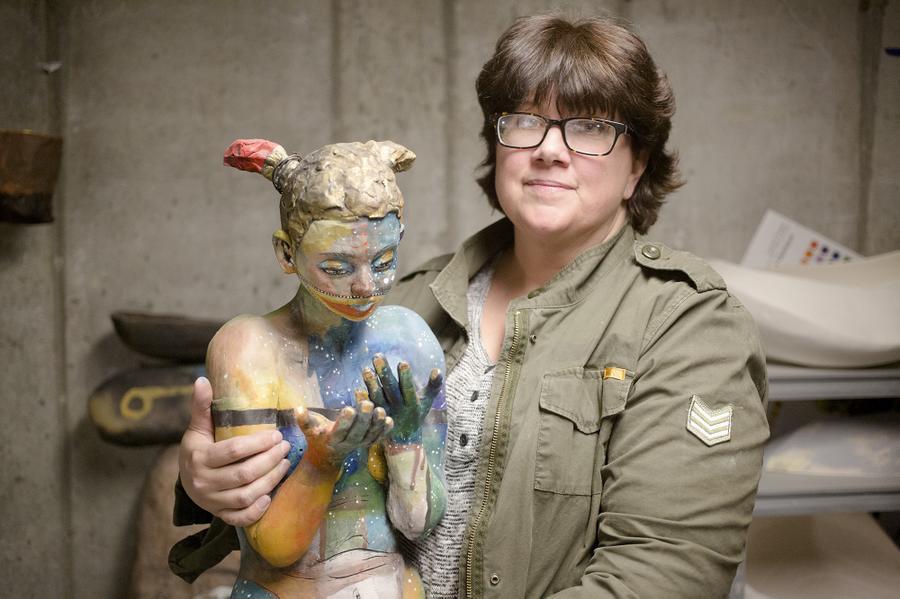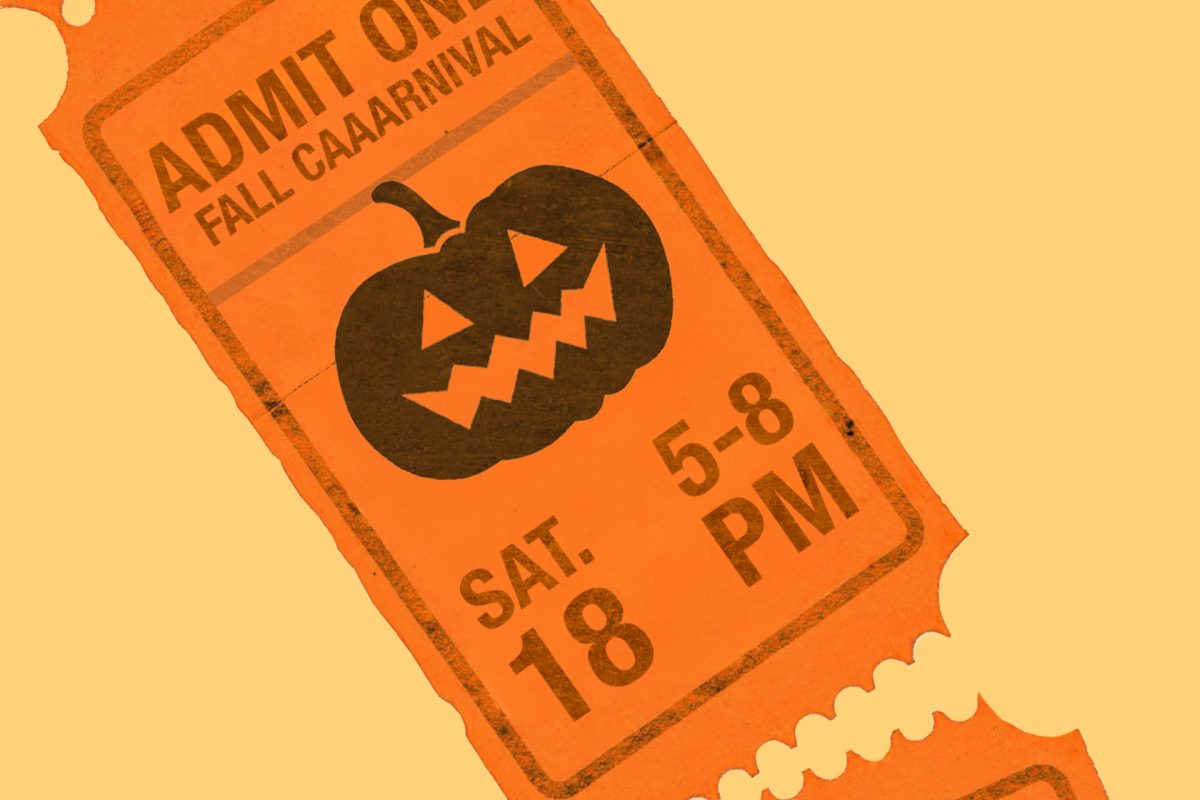The artist stands next to a dark ceramic horse that’s nearly as tall as she is. The form is realistic, but the horse’s neck is an earthy blue. Now, she paints white circles over it.
Graduate student Marni Gable, a ceramicist, has a studio tucked in the corner of the basement of the Hitt Street Studio. She sometimes spends nearly 60 hours a week here.
Her basement creative space is filled with large ceramic sculptures and shelves of the paints, glazes, kiln equipment and clay that make her creations possible.
Prior to starting graduate school, Gable taught high school art for several years. She enjoyed being a teacher, she said, but spent so much time focusing on meeting student needs that she couldn’t create her own art.
“When you’re a teacher, your work is your students,” Gable said. “You miss that making. You don’t have time. I turned 50 this year. If (grad school) is going to happen, it better happen now, because it’s probably never going to happen if I don’t. And it’s been great. I’ve had three years of slaving away in a basement, but my work has changed, and the way I think about life has changed, and I’m glad I did it.”
The surfaces of her large-scale works are dark and rough, but are covered with many layers of vibrantly colored designs. These designs, she said, help her discover her personal history.
Gable was adopted when she was 6 weeks old. When she was 42, she reconnected with her birth mother. Her birth father had died, and she couldn’t find information about his side of the family. She then found out that her grandmother was adopted, too; a brick wall, Gable said.
Then she found out that her great-grandfather had fought in the Civil War but he defected, stole somebody else’s dog tags and went by that name for the rest of his life. Another brick wall.
As Gable’s family could not link her to her heritage, she began using ceramics to shape it herself.
“This whole body of work is about our ancestry as human beings and also specifically our ancestry as far as what culture we identify with,” she said. “So being able to manufacture that for yourself and create your own identity is an interesting thought.”
Although Gable could have her DNA tested to figure out her exact ethnic heritage, she said she hasn’t done this — she doesn’t feel the need to know for sure.
“The reason I haven’t is because maybe that’s not what’s important,” she said. “It’s the stories that you’re missing. It’s that link to a way of life that maybe just knowing that you are from northern Europe doesn’t really tell you.”
To find these stories, Gable is going back in the human timeline, far beyond 20th-century European immigration.
“I feel like I’ve gone back far enough to a tribal era that we all can relate to,” Gable said. “I’m drawing as far back as I can go to try to include everybody.”
Some of Gable’s pieces resemble Native American totems. The abstract-seeming shapes of these totems, she explained, are a combination of human figures and stone and tree forms.
“It’s sort of the idea of the (Big Bang),” Gable said. “Going way back, ancestry-wise, trees and stones and people were all created from the same thing. We’re all stardust. So I make these amorphous sort of unidentifiable shapes, thinking that I’m trying to tie together the elements of everything in the world.”
Gable’s pieces are decorated whimsically, with colorful tribal- and African-inspired designs, depictions of artifacts of modern pop culture and universal scenes that many people experience.
“For me, the imagery on these pieces tell stories,” Gable said. “So it gives your imagination some room to play about where you came from and what those people were like and what they did.”
Gable shares her studio space with Leah Bowring, another ceramic artist pursuing a master of fine arts in ceramics.
Bowring’s pottery mainly consists of white sculptural vessel forms of all shapes and sizes. They are thin, lightweight and flowing, which Bowring said represents the feeling she experiences while running long distances.
The aesthetic of Bowring’s ceramics sharply contrasts that of Gable’s. Despite this, the two work very well together, Bowring said.
“We have very different ideas of what we want our work to be, but what makes it work well is just our general excitement for art and all the ideas that can exist,” she said. “We’re both extremely excitable and enthusiastic about each other’s work and about art continuing in the world.”
The two shared studio space during their first year of the three-year MFA program. The next year, they were apart, but returned to sharing space this year. Bowring said she missed her “Marni time.”
“Marni is my best friend in town,” she said. “I’m very happy to have her. We’ve both gone through some hard times in our work, and we’ve been there for each other, as melodramatic as that sounds.”
Bowring said that Gable is constantly questioning, rethinking and looking for alternatives, and this heavy thinking is released through her ceramics.
“Her brain is always trying to solve something, so I think that shows in her work, with all the layers of questions and stories and narratives and things that have united us as human beings since the beginning of time,” Bowring said. “In the end, anything personal is also universal because we’re all the same in a lot more ways than we’re different.”
It is the instructors in the art department that help turn these abstract ideas into tangible objects.
Gable receives guidance from Joe Pintz, an assistant professor of art who mainly focuses on ceramics. He said for graduate-level students, he takes on a mentoring role and helps them to align their intentions for the meaning of their work with what they’re physically creating.
He also advises graduate students on potential colors and glaze recipes to use, as well as firing and assembly techniques.
“Those are things that I work with the grads one-on-one with, because they each have very different needs and projects that they’re working on,” Pintz said. “So I try and tailor my information to each one of them. I meet with them individually as well as a group to give them that custom mentoring that they need. In the case of Marni, she had a strong interest in the figure and wanted to pursue that and really dig deep into that.”
Gable’s upcoming MFA thesis show, aptly entitled “Artifacts of an Invented Ancestry,” will run from April 20 to May 1 at the George Caleb Bingham Gallery.
Gable said she encourages everyone to check out her show and attend the closing reception at 4 p.m. April 30, but she won’t say what she wants the takeaways to be. While some artists specify the emotions their art is designed to evoke, Gable is hesitant to tell anybody what to feel.
“I think you’re going to identify with a piece of art or you’re not,” she said. “I just want people to feel whatever they feel. Experience it, and if they relate to it, that’s wonderful, and if they don’t, there’s something they will. That’s the way art is.”








